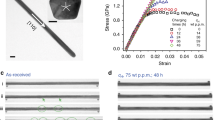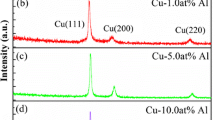Abstract
Epitaxial-Bain-Path and Uniaxial-Bain-Path studies reveal that a B2-CuZr nanowire with Zr atoms on the surface is energetically more stable compared to a B2-CuZr nanowire with Cu atoms on the surface. Nanowires of cross-sectional dimensions in the range of ~20–50 Å are considered. Such stability is also correlated with the initial state of stress in the nanowires. It is also demonstrated here that a more stable structure, i.e., B2-CuZr nanowire with Zr atoms at surface shows improved yield strength compared to B2-CuZr nanowire with Cu atoms at surface site, over range of temperature under both the tensile and the compressive loadings. Nearly 18% increase in the average yield strength under tensile loading and nearly 26% increase in the averaged yield strength under compressive loading are observed for nanowires with various cross-sectional dimensions and temperatures. It is also observed that the B2-CuZr nanowire with Cu atom at the surface site shows a decrease in failure/plastic strain with an increase in temperature. On the other hand, B2-CuZr nanowires with Zr at the surface site shows an improvement in failure/plastic strain, specially at higher temperature as compared to the B2-CuZr nanowires which are having Cu atoms at the surface site. Finally, a possible design methodology for an energetically stable nano-structure with improved thermo-mechanical properties via manipulating the surface atom configuration is proposed.








Similar content being viewed by others
References
Alippi P, Marcus PM, Scheffler M (1997) Strained tetragonal states and Bain paths in metals. Phys Rev Lett 78:3892
Cheng YQ, Ma E, Sheng HW (2008) Alloying strongly influences the structure, dynamics, and glass forming ability of metallic supercooled liquids. Appl Phys Lett 93:111913
Clausius R (1870) On a mechanical theorem applicable to heat. Phil Mag 40:122–127
Das J, Tang MB, Kim KB, Theissmann R, Baier F, Wang WH et al (2005) “Work-hardenable” ductile bulk metallic glass. Phys Rev Lett 94:205501
Diao J, Gall K, Dunn ML (2003) Surface-stress-induced phase transformation in metal nanowires. Nat Mater 2(10):656–660
Duan G, Lind ML, Blauwe KD, Wiest A, Johnson WL (2007) Thermal and elastic properties of Cu–Zr–Be bulk metallic glass forming alloys. Appl Phys Lett 90:2119001
Fang J, You H, Kong P, Ding B, Song X (2008) Size-dependent structure transformation from amorphous phase to crystal. Appl Phys Lett 92:143111
Finnis MW, Sinclair JE (1984) A simple N-body potential for transition metals. Philos Mag A 50:45
Hoover WG (1985) Canonical dynamics: equilibrium phase-space distributions. Phys Rev A 31:1695–1697
Inoue A (2002) Stabilization of metallic supercooled liquid and bulk amorphous alloys. Acta Mater 48:279
Inoue A, Takeuchi A (2002) Recent progress in bulk glassy alloys: bulk amorphous, nano-crystalline and nano-quasicrystalline alloys IV. Mater Trans, JIM 43:1892
Inoue A, Zhang W (2004) Formation, thermal stability and mechanical properties of Cu–Zr and Cu–Hf binary glassy alloy rods. Mater Trans 45:584
Inoue A, Zhang T, Masumoto T (1990) Production of amorphous cylinder and sheet of La55Al25Ni20 alloy by a metallic mold casting method. Mater Trans, JIM 31:425
Inoue A, Zhang W, Zhang T, Kurosaka K (2001) High-strength Cu-based bulk glassy alloys in Cu–Zr–Ti and Cu–Hf–Ti ternary systems. Acta Mater 49:2645
Jakse N, Pasturel A (2008) Glass forming ability and short-range order in a binary bulk metallic glass by ab initio molecular dynamics. Appl Phys Lett 93:113104
Johnson WL (1999) Bulk glass-forming metallic alloys: science and technology. Mater Res Bull 24:42
Kim KB, Das J, Baier F, Tang MB, Wang HW, Eckert J (2006) Heterogeneity of a Cu47.5Zr47.5Al5 bulk metallic glass. Appl Phys Lett 88:051911
Kumar G, Ohkubo T, Mukai T, Hono K (2007) Plasticity and microstructure of Zr–Cu–Al bulk metallic glasses. Scripta Mater 57:173
LAMMPS (2010) http://www.cs.sandia.gov/~sjplimp/lammps.html
Lekka CE, Ibenskas A, Yavari AR, Evangelakis GA (2007) Tensile deformation accommodation in microscopic metallic glasses via subnanocluster reconstructions. Appl Phys Lett 91:214103
Lund AC, Schuh CA (2003) Atomistic simulation of strain-induced amorphization. Appl Phys Lett 82:13
Mclellan AG (1974) Virial theorem generalized. Am J Phys 42:239–243
Mendelev MI, Ackland GJ (2007) Development of an interatomic potential for the simulation of phase transformations in zirconium. Phil Mag Letts 87(5):349–359
Nose SA (1984) A unified formulation of the constant temperature molecular dynamics methods. J Chem Phys 81:511–519
Pauly S, Das J, Mattern N, Kim D H, Eckert J (2009) Phase formation and thermal stability in Cu–Zr–Ti(Al) metallic glasses Intermetallics 17(6):453–462
Peker A, Johnson WL (1993) A highly processable metallic glass: Zr41. 2Ti13. 8Cu12. 5Ni10. 0Be22. 5. Appl Phys Lett 63:2342
Plimpton SJ (1995) Fast parallel algorithms for short-range molecular dynamics. J Comput Phys 117:1–19
Sutrakar VK, Mahapatra DR (2008) Formation of stable ultra-thin pentagon Cu nanowires under high strain rate loading. J Phys: Condens Matter 20:335206
Sutrakar VK, Mahapatra DR (2009a) Coupled effect of size, strain rate, and temperature on the shape memory of a pentagonal Cu nanowire. Nanotechnology 20:045701
Sutrakar VK, Mahapatra DR (2009b) Stress-induced phase transformation and pseudo-elastic/pseudo-plastic recovery in intermetallic Ni–Al nanowires. Nanotechnology 20:295705
Sutrakar VK, Mahapatra DR (2009c) Stress-induced martensitic phase transformation in Cu–Zr nanowires. Mater Lett 63:1289–1292
Sutrakar VK, Mahapatra DR (2009d) Comment on “Pseudoelasticity of Cu–Zr nanowires via stress-induced martensitic phase transformations”. Appl Phys Lett 95:136101
Sutrakar VK, Mahapatra DR (2010) Single and multi-step phase transformation in CuZr nanowire under compressive/tensile loading. Intermetallics 18:679–687
Sutrakar VK, Mahapatra DR (2011) Universal stability and temperature dependent phase transformation in group VIIIB-IB transition metal FCC nanowires. J Phys Chem C 115:10394–10398
Swenson RJ (1983) Comments on virial theorems for bounded systems. Am J Phys 51:940–942
Tsai DH (1979) The virial theorem and stress calculation in molecular dynamics. J Chem Phys 70:1375–1382
Wang WH, Dong C, Shek HC (2004) Bulk metallic glasses. Mater Sci Eng, R 44:45
Wang XD, Yin S, Cao QP, Jiang JZ, Franz H, Jin JH (2008) Atomic structure of binary Cu64.5Zr35.5 bulk metallic glass. Appl Phys Lett 92:011902
Zhang T, Inoue A, Masumoto T (1991) Amorphous Zr–Al–TM (TM = Co, Ni, Cu) alloys with significant supercooled liquid region of over 100 K. Mater Trans, JIM 32:1005
Zhou M (2003) A new look at the atomic level virial stress: on continuum-molecular system equivalence. Proc R Soc A 459:2347–2392
Author information
Authors and Affiliations
Corresponding author
Rights and permissions
About this article
Cite this article
Sutrakar, V.K., Mahapatra, D.R. Designing copper–zirconium based nanowires for improving yield strength and plasticity by configuring surface atoms. J Nanopart Res 13, 6907–6918 (2011). https://doi.org/10.1007/s11051-011-0598-2
Received:
Accepted:
Published:
Issue Date:
DOI: https://doi.org/10.1007/s11051-011-0598-2




